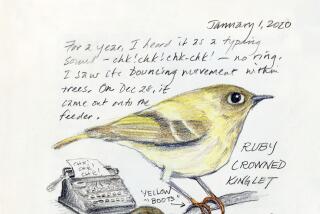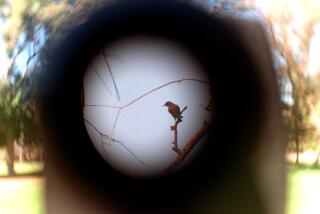BOOK REVIEW : A Walk Through Nature--With a Poet : THE BIRD OF LIGHT<i> by John Hay</i> W. W. Norton & Co. $18.95, 176 pages
John F. Kennedyâs maternal grandfather, Boston mayor âHoney Fitzâ Fitzgerald, rarely lost a battle. But he met his match one day when he was out walking with his daughter Rose on a beach near the Kennedy family compound on Cape Cod. The two disturbed a flock of nesting terns--the small, excitable sea birds that are the subject of this book--and the testy birds attacked and routed them.
Bent on revenge, the humiliated politician did everything in his power to rid Massachusetts beaches of terns, even threatening to push through special federal legislation, reports John Hay in this captivating tribute to his favorite bird.
Author Hay, a longtime resident of Cape Cod, is a winner of the Burroughs Medal, the equivalent of a Nobel Prize in the little world of nature writing. This is his 12th book, and his second on the embattled tern, which is known for its long seasonal migrations.
âThe Bird of Lightâ refers concretely to the acrobatic ternsâ affinity for the sun. âThey rise up,â Hay writes, âdip, turn, and swing like a casting of silver facets into the air, or dancing flowers, alternating the dark shading of their backs and the white of their bellies. When they flip over on their sides, reflecting the sunlight, it is as if they were deliberately courting it.â
Sunlight, for Hay, carries an abstract and personal meaning that is central to the book. It represents life in its unmediated form, nature in all its exhilarating and terrifying rawness, an experience Hay imagines is tantalizingly beyond the grasp of cosseted, air-conditioned contemporary humans, himself included.
Terns, fleeing winter in their legendary migrations, fly at up to 50 m.p.h. and 20,000 feet, âspeeding ahead on a high plane of sacrifice and commitment,â Hay writes, adding mournfully, âWe, who only follow money and the clock, are left behind.â
The Cape Cod terns survived Honey Fitz, Hay writes, but now theyâre succumbing to a more familiar and pervasive threat--the burgeoning human population. Developers and beach-goers, especially drivers of off-road vehicles, are pushing the birds out of their nesting areas, and the tern population is plummeting.
Other birds, too, are crowding out the skittish terns, particularly the birdsâ larger relatives, the gulls, which thrive on the garbage left by the growing crowds of people.
At first glance, âThe Bird of Lightâ seems a typical, if unusually stylish, example of nature writing. The book is loosely structured around a year in the life of Grayâs Beach, a large sand dune on the seaward rim of a salt marsh near the authorâs Cape Cod home. Hay packs the slim volume with personal observations and easy-to-digest facts about terns and other animals that populate the shores and offshore waters of the Northeast, from horseshoe crabs to humpback whales.
But a closer look reveals that the book is no ordinary natural history, and it is only fair to warn down-to-earth nature lovers that the book requires considerable receptivity to abstraction.
For Hay, objective facts alone lead to a remote and unsatisfying form of knowledge. They cannot produce the intimate knowledge he desires: a mental union with nature, such as what American Indians are said to experience when contemplating their totemic animals. Hay seems to believe that scientific knowledge actually precludes this sort of union. âWhile one world overcomes the elements,â he writes, âanother incorporates them.â
Torn between these two worlds, Hay collects facts while viewing the tern as a sort of totem. âAs a non-scientist, I am about as far from reaching scientific conclusions as I am from a final knowledge of the birds themselves. But it is the open-ended experience of a common earth that moves my curiosity. The birds help me to reach.â
In his frequent reaching for the not-quite-graspable, Hay is, like his spiritual predecessor Loren Eiseley, as much a romantic poet in the tradition of Shelley as a nature writer. Contemplating even the most ordinary object can engender in him a startling chain of mind-stretching associations.
âI also found a fragile cup, all that was left of a broken egg shell, a symbol of where life begins, the shell of the womb, the shape of the globe itself.â
Yet, for all his visionary otherworldliness, Hay is a man of his time, and âThe Bird of Lightâ should take its place among the most eloquent pleas to save the planet from its human inhabitants. It can be seen perhaps as a quiet answer to Bill McKibbenâs âThe End of Nature.â In contrast to that apocalyptic battle hymn, Hayâs book is a still, small chapel in which every line leads to the high altar, and on that altar, never quite in perfect focus, stands the brilliant bird of light, drawing the reader ever upward.
To readers willing to submit fully to it, this book offers an imaginative experience of rare intensity. Every paragraph should be savored.
Next: Jonathan Kirsch reviews âSignposts in a Strange Landâ by Walker Percy (Farrar Straus & Giroux) .
More to Read
Sign up for our Book Club newsletter
Get the latest news, events and more from the Los Angeles Times Book Club, and help us get L.A. reading and talking.
You may occasionally receive promotional content from the Los Angeles Times.








